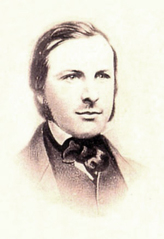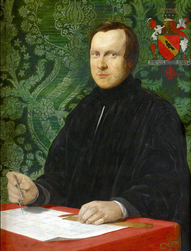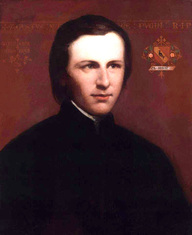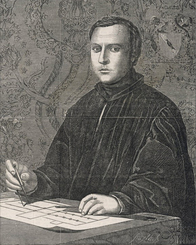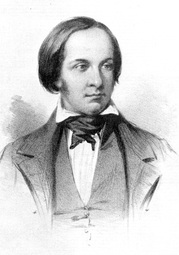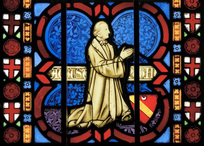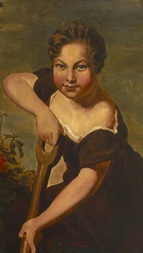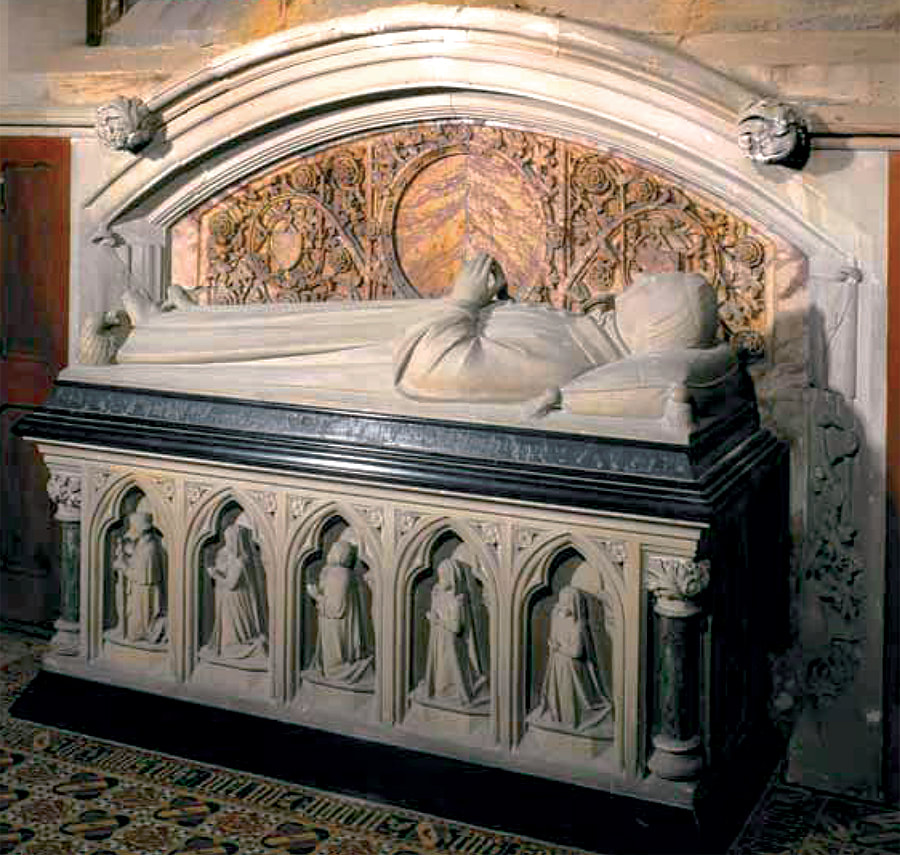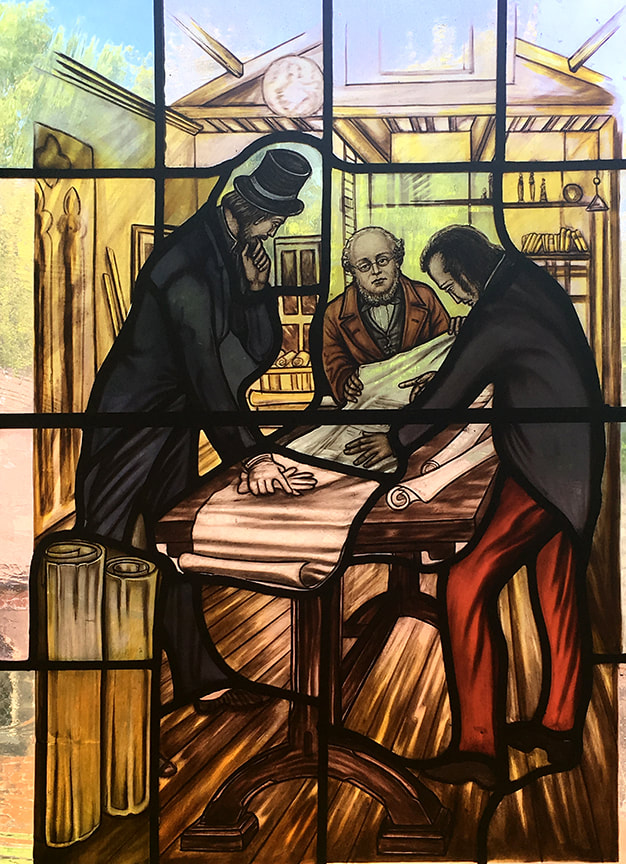Family Tree
|
 |
|
|
See Pugin's FindA Grave info HERE
Window at St Mary's Convent, Handsworth, showing, from l-r, Lord Shrewsbury, John Hardman, and Pugin |
Augustus Welby Northmore Pugin, 1812-1852
some details taken from Alexandra Wedgwood's A. W. N. Pugin and the Pugin Family 1812
Augustus Welby Northmore Pugin is born on 1 March at 39 Keppel Street, Russell Square, London, to architectural illustrator Augustus Charles Pugin (c. 1769-1832) and Catherine Welby (?-1833). Educated partly at Christ’s Hospital, the younger Pugin went on expeditions with the pupils in his father’s architectural school, including several trips to France. 1827 Employed by royal goldsmiths Rundell & Bridge to design gothic furniture, still in place today, for the royal apartments at Windsor Castle 1829 Joins the staff of the English Opera House before moving to Covent Garden as a stage carpenter and scene painter, but is soon designing sets and costumes Introduced to the Scottish architect James Gillespie Graham for whom he begins drawing Establishes his own business designing and making furniture, which ultimately failed 1831 Designs stage scenery for the ballet Kenilworth Purchases a sailing boat 1832 Marries Anne Garnett (1814-1832) who dies one week after giving birth to their daughter, also named Anne Father A C Pugin dies Begins drawing his first series of ‘ideal schemes’ Concentrates on training as an architect by making intensive study tours of medieval buildings 1833 Marries his second wife, Louisa Button (c. 1813-1844) Completes the second volume of his father's Examples of Gothic Architecture Mother Catherine Welby Pugin dies Moves to Ramsgate 1834 Collaborates with antique dealers including Edward Hull Begins making his annual sketching trips to the continent Second child and first son Edward Welby born Fire destroys most of the Palace of Westminster, including the two Houses of Parliament 1835 Moves to his self-designed home St Marie’s Grange, near Salisbury Meets Charles Barry and designed interiors for him at King Edward VI Grammar School in Birmingham Publishes Gothic Furniture, his first book of designs Converts to Roman Catholicism Barry employs Pugin to design the Gothic detail required in the competition to build the new House of Parliament 1836 Continues to help Charles Barry after the latter wins the competition to design the new Houses of Parliament Third child and second daughter Agnes born Publishes his most famous book, Contrasts, a polemical comparison showing the 'present decay of taste' compared to medieval architecture 1837 Completes the estimate drawings for Barry Starts work on his first contribution to country house architecture, adding extensive Gothic details to Scarisbrick Hall in Lancashire Begins collaborating with St Mary’s College, Oscott, where he would become Professor of Ecclesiastical Architecture Meets the Birmingham metalwork provider John Hardman and John, the 16th Earl of Shrewsbury, who becomes a prominent Catholic patron Relocates to London after selling St Marie’s Grange 1838 Begins work on his first major church, St Mary's in Derby Makes his first trip to Ireland for a number of commissions Undertakes summer trip through Germany and Switzerland Meets the builder George Myers Hardman begins to manufacture metalwork to Pugin’s designs 1839 Designs churches including St George, Southwark, St John’s Hospital, Alton, St Wilfrid, Hulme, and St Chad's in Birmingham, the first cathedral built in England since the Reformation 1840 Designs St Giles, Cheadle, the Bishop’s House, Birmingham, and the College of St Cuthbert, Ushaw Starts working with the pottery manufacturer Herbert Minton Fourth child and second son Cuthbert born Develops friendships with several Tractarians at Oxford |
|
1841
Publishes a second edition of Contrasts and the first edition of The True Principles of Pointed or Christian Architecture Fifth child and third daughter Katharine born Begins work on cathedrals in Newcastle and Nottingham St Chad’s in Birmingham opens 1842 Writes articles for The Dublin Review Continues work on churches including the Cathedral at Killarney Visits Ireland once and Scotland twice 1843 Designs for Balliol College, Oxford, are rejected Starts building a new family home, The Grange, in Ramsgate Sixth child and fourth daughter Mary born Publishes An Apology for the Revival of Christian Architecture in England which features a frontispiece showing three cathedrals and twenty-two other religious buildings designed by him 1844 Begins his association with the interior decorator J. G. Crace Publishes The Glossary of Ecclesiastical Ornament and Costume Second wife Louisa, mother of five of his children, dies Returns to work with Barry on the interior designs for the Houses of Parliament where he utilizes the skills of his colleagues Hardman, Minton, and Crace 1845 Begins building the Catholic church of St Augustine next door to his own home in Ramsgate Hardman begins manufacturing Pugin’s stained glass Commissioned to rebuild the Catholic College of St Patrick, Maynooth Visits Ireland three times 1846 Consecration of St Giles in Cheadle, Staffordshire Decline in architectural commissions 1847 Makes his longest continental tour, leaving England at the end of March, travelling to Italy and returning home in the middle of June Barry's new House of Lords is opened, with lavishly beautiful interiors and furnishings by Pugin Makes three subsequent brief trips across the Channel Undertakes much domestic work with J. G.Crace 1848 Meets and marries Jane Knill (1827-1909), with whom he has two more children St George, Southwark opens to much criticism, particularly regarding rood screens Designs major additions to Alton Towers and Alton Castle 1849 Focuses his attention on his church of St Augustine Seventh child and fifth daughter Margaret born Designs much stained glass, metalwork, tiles, and internal decorations Publishes Floriated Ornament 1850 His daughter Anne marries John Hardman Powell, nephew to Hardman of Birmingham Publishes a pamphlet to address recent criticism Continues his decorative work with Hardman, Minton, Myers and Crace in preparation for the Great Exhibition 1851 The Medieval Court at the Great Exhibition, showcasing examples of Pugin's designs and his collaborators’ craftsmanship, is praised Eighth child and third son Peter Paul born Publishes A Treatise on Chancel Screens and Rood Lofts 1852 Queen Victoria opens the new Houses of Parliament, but Pugin does not attend and there is hardly a mention of his involvement After years of strain and overwork, Pugin has a nervous breakdown and he is certified insane Pugin dies, at home in Ramsgate, on 14 September and is buried in the chantry of the church he is building next door, St Augustine's 1858 The clock tower at Westminster, designed by Pugin and now commonly known now as Big Ben, is completed |
